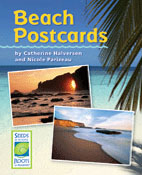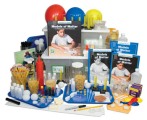Introduce Students to Concepts About Shorelines and Beaches
May 31, 2013 at 4:04 pm Leave a comment
 Most students have heard the terms “beach” and “shoreline,” but do they know the difference?
Most students have heard the terms “beach” and “shoreline,” but do they know the difference?
Here are some important concepts for students:
- a shoreline is a place where water meets land
- a beach is a shoreline where people can walk near the water
- beaches are covered with loose material
- beaches can be rocky, sandy, or covered with coral or beach wrack
In the Seeds of Science/Roots of Reading® book Beach Postcards, students can read an account of a girl named Jo, who visits beaches around the world with her family, and sends postcards back to her friend Linn. Linn writes a report about what she learned about beaches and shorelines from Jo’s postcard. In addition to conveying the concepts bulleted above, the book is also designed to help students who may have limited knowledge of shorelines to imagine the experience of being at various beaches.
Below are some questions you can pose using content taken from the book.
How is a beach different from some kinds of shorelines?
Explain that the place where water meets the land is called a shoreline. There are many kinds of shorelines all around the world.
Beaches are one kind of shoreline. Beaches are shorelines where people can walk beside the water. Beaches are covered with loose material like rocks or sand. Beaches can form along lakes, rivers, and the ocean.
What do you think you would see if you were standing on a rocky beach? What would you feel? What would you wear to visit this beach?
Explain that rocky beaches are covered with rocks and pebbles. Some of the rocks are big. The pebbles are small.
Rocks and pebbles get to the beach in many ways. Rocks can fall onto the beach from cliffs. Rocks on the beach can break and become pebbles. Rocks and pebbles can be carried to the beach by waves or rivers. There may be no sand there, but it is still a beach.
Why do you think it might be hard to walk on a coral beach?
Explain that corals are very small animals with hard body coverings. Thousands of these animals together make a coral reef. Sometimes big waves hit a coral reef. The waves break the hard parts of dead coral animals into pieces. The waves carry the coral pieces to the beach. Over time, coral sand covers the beaches.
What makes beach wrack a good home for the animals that live there?
Explain that strong waves carry many things to the beach. The waves bring seaweed, shells, and even trash. Sometimes the waves bring plants and animals to the beach. All these things together are called beach wrack.
Beach wrack makes a great home for small animals. Some animals live their whole lives in beach wrack. They can eat seaweed. Crabs and birds find these small animals to eat in beach wrack.
Provide more experience.
After you’ve reviewed the questions and answers about beaches, you can extend the learning with a map activity.
Distribute a world map and highlighter to student groups and have them highlight all the shorelines they can find. Circulate to reinforce the concept that shorelines are not just around the continents – there are also very many shorelines within the continents, along rivers and lakes. Have each student in the group place a finger on the map where water meets land. After a minute or two, have students take turns showing the place they selected. Say “All of these places, where the water meets the land are called shorelines. Shorelines can be on rivers, oceans, or in bays. They can be where saltwater or freshwater meets the land. They are all different, but they are all in places where water meets the land.”
For more information about the student book Beach Postcards and the Shoreline Science science and literacy unit, visit http://www.scienceandliteracy.org.
Do you want to be notified when we publish new blog articles? Simply enter your email address in the “Follow Blog via Email” box located in the right sidebar.
Entry filed under: Informational text, Teaching Science Concepts. Tags: 2nd grade science, 3rd grade science, beach, elementary curriculum, elementary lesson plans, elementary school science, elementary science, life science, science classroom, science resources, science teachers, second grade science, shoreline, Shoreline Science, third grade science.








Trackback this post | Subscribe to the comments via RSS Feed